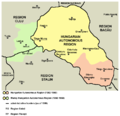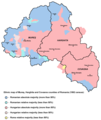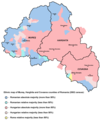The Székely Land (pronounced [ˈseːkɛj]; Hungarian: Székelyföld; Romanian: Ţinutul Secuiesc; German: Szeklerland; Latin: Terra Siculorum) or Szekler Land refers to the territories inhabited mainly by the Székely, a Hungarian-speaking ethnic group[1] from eastern Transylvania. They live in the valleys and hills of the Eastern Carpathian Mountains, corresponding to the present-day Harghita, Covasna, and parts of Mureş Counties in Romania.
Originally, the name Székely Land denoted an autonomous region within Transylvania. It existed as a legal entity from medieval times until the Austro-Hungarian Compromise of 1867, when its role was replaced by the county system. Along with Transylvania, it became part of Romania in 1920, returned to Hungary in 1940 and was again attached to Romania in 1945. The area was an autonomous region within Romania between 1952–1968, and today there are Székely autonomy initiatives to reach a higher level of self-governance for the Székely Land within Romania.
Contents[hide] |
[edit] Population
The area of the region is of about 13,000 km2. The population of the Székely Land (according the last census, held in 2002) is 809,000, 612,043 of them Székely Hungarians, namely 75.65%.[2] The Székely represent 59% of the populations of Harghita, Covasna and Mureş counties. The percentage of Székely is higher in Harghita and Covasna (84.6% and 73.8% respectively), and lower in Mureş County, not all of which falls inside the traditional region (39.3%).
[edit] Geography
Historically centred in the town of Târgu-Mureş (Marosvásárhely), other important centers of the Székely Land are Miercurea Ciuc (Csíkszereda), Sfântu Gheorghe (Sepsiszentgyörgy), and Odorheiu Secuiesc (Székelyudvarhely).
[edit] History
From the 12th and 13th centuries until 1876, the Székely Land enjoyed a considerable but varying amount of autonomy, first as a part of the Kingdom of Hungary, then inside the Principality of Transylvania, and finally as a part of the Habsburg Empire. The autonomy was largely due to the military service the Székely provided until the beginning of the 18th century. The medieval Székely Land was an alliance of the seven autonomous Székely Seats of Udvarhely, Csík, Maros, Sepsi, Kézdi, Orbai and Aranyos. The number of seats later decreased to five, when Sepsi, Kézdi and Orbai Seats were united into one territorial unit called Háromszék (literally Three Seats).
As a result of the Austro-Hungarian Compromise of 1867, Transylvania became again part of the Kingdom of Hungary within Austria-Hungary and ceased to exist as a separate legal or administrative entity. In 1876, a general administrative reform abolished all the autonomous areas in the Kingdom of Hungary and created a unified system of counties. As a result, the autonomy of the Székely Land came to an end as well. Four counties were created in its place: Udvarhely, Háromszék, Csík, and Maros-Torda. (Only half of the territory of Maros-Torda originally belonged to Székely Land.) The isolated Aranyosszék became a district of Torda-Aranyos county.
In the Treaty of Trianon of 1920 following World War I, the Kingdom of Romania acquired Transylvania. The Romanian language officially replaced Hungarian in Székely Land, but Székely county boundaries were preserved, and Székely districts were able to elect their own officials at local level and to preserve Hungarian-language education.
In 1940, Romania was forced to cede Northern Transylvania back to Hungary in the Second Vienna Award; this territory included most of the historical Székely areas. Hungarian authorities subsequently restored the pre-Trianon structure with slight modifications.
[edit] Autonomy
Following the territory's return to Romania after World War II, a Hungarian Autonomous Region was created in 1952, which encompassed most of the land inhabited by the Székely. This region lasted until 1968 when the administrative reform divided Romania into the current counties. Roughly speaking, present-day Harghita County encompasses the former Udvarhely and Csík, the latter including Gyergyó; Covasna County covers more or less the territory of the former Háromszék; and what was once Maros-Torda is mostly part of present-day Mureş County. The former Aranyosszék is today divided between Cluj and Alba Counties.
After the fall of communism, many hoped that the former Hungarian Autonomous Region, abolished by the Ceauşescu regime, would soon be restored again. This has not happened; however, there are Székely autonomy initiatives[3][4] and further efforts from Székely organisations to reach a higher level of self-governance for the Székely Land within Romania.
On 2 February 2009, Romanian President Traian Băsescu met with Hungarian President László Sólyom in Budapest and discussed the issues of minority rights and regional autonomy. Băsescu affirmed "The Hungarian minority will never be given territorial autonomy".
[edit] Tourist attractions

- Székely fortified churches - more than 20 Székely villages count fortified churches
- Baroque church at Şumuleu Ciuc (Csíksomlyó), a major Roman Catholic pilgrimage site
- Rural tourism
- Hiking in the Carpathians
- Mofette, spas
- Mineral springs, thermal baths
- Salt mines (treatment against allergy and asthma)
- Traditional Székely handicrafts (pottery, wood carving)
- Mikó Castle
- Teleki Library
- Székely National Museum (Székely Nemzeti Múzeum), Sfântu Gheorghe/Sepsiszentgyörgy
- Szekler Museum of Ciuc {Csíky Székely Múzeum), Miercurea-Ciuc/Csíkszereda
- (COPY OF WIKIPEDIA)










No comments:
Post a Comment